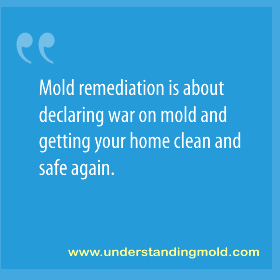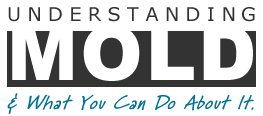re·me·di·a·tion (riˌmēdēˈāSHən)
noun. The action of remedying something, in particular of reversing or stopping environmental damage.

If there is a very small amount of mold or a very small area is affected, you may be able to do the clean up yourself. However it is important that you protect yourself.
If mold is hidden behind walls, do not cut it open or go prodding around. If you do, you can release spores into the air which can contaminate more of your house and is risky for your health. You’ll need to be wise about getting professionals involved that can help you.
General Steps that are Very Important
At a very high level, what you do and the order you do them, is extremely important:
- Fix the leak and all sources of the moisture.
- Remove damaged materials.
- If you are doing it yourself, be sure to protect yourself.
- Remove any materials that are wet. Cut out drywall about a foot or two beyond where you find any moisture damage or mold. This may seem extreme, but mold can start forming in as little as 24 hours. So many people have gotten sick from moldy and water damaged homes. Your health is so important and it will be cheaper in the long run to fix it properly the first time.
- DO NOT USE BLEACH.
I cannot stress the importance of this enough. It is a common myth that bleach kills mold. It doesn’t. Mold spores go dormant and then next time any moisture is introduced, the spores start growing again with a renewed vengeance.
- Treat (remediate) any affected areas for mold spores.
- If you are attempting to take care of a small amount of mold yourself, there are products out there that you can buy that are designed to kill mold. Our favorite is Concrobium, an odorless non-toxic product that encapsulates mold spores and crushes them.
- Make sure everything is dry before closing any walls back up.
Pre & Post Remediation Testing
The full situation of the mold problem needs to be assessed before it starting cleanup. This is to protect you and your home. If you are randomly opening walls and start pulling apart materials, you risk contaminating not only yourself but your entire house. There may be a lot more mold there than what is visible.
First, you’ll first want to contact a mold inspector or mold hygienist. It is their job to be a detective and really scope out the problem. They will give you a full report that includes a remediation plan. Remediation companies bidding on your job will use the remediation plan to give you an estimate and perform the remediation.
A remediation plan includes:
- The affected area(s) and systems (plumbing/HVAC) involved
- Cleanup methods
- Protective equipment
- Containment barriers
After the remediation is completed, it is best to have your inspector or hygienist back to verify the remediation was successful; that the moisture issue has been fixed and mold removal was performed properly. This is how you have confidence to know that the job was done right.
What Happens During Remediation?
The goal of remediation is to remove or clean mold-damaged materials using work practices that protect occupants by controlling the dispersion of mold from the work area and protect remediation workers from exposures to mold. In all situations, the underlying moisture problem must be corrected to prevent recurring mold growth. Indoor moisture can result from numerous causes, such as: façade and roof leaks; plumbing leaks; floods; condensation; and high relative humidity. An appropriate building expert may be needed to identify and repair building problems. An immediate response and thorough cleaning, drying, and/or removal of water-damaged materials will prevent or limit microbial growth.1
Mold remediation is serious business. Here are the basics of a professional remediation:1
- Conducted by trained personnel, that are taking measures to protect themselves (respirators, gloves, eye protection and sometimes coveralls).
- Done while you are NOT in the home. If you or anyone else is there, take measures to protect yourself. If you have been sick, you really shouldn’t be there even if it is a very small mold issue
- Performed in a contained area with negative airspace. Plastic sheeting is used to make a containment area around the area where the mold will be remediated. Negative airspace is created so that any spores released are sucked and carried directly outside. The HVAC system is usually shut down and air vents in this area are sealed. If more mold is released into the environment, you don’t want it spreading through the entire house.
- Moldy materials are sealed in plastic bags and removed from the house. Again, if not contained, other areas can be contaminated when carrying out mold covered items. Every effort possible is made to reduce dust and stirring the environment up.
- Wood studs should be sanded to remove any mold and metal studs would be treated and wiped down.
- Household surfaces should be wiped down with a soap or special solution. Remediators may spray the house with a mold killing solution or chemical. You can request chemical data sheets for all the products the remediator plans to use to be informed, check with your doctor and try to make sure you will be okay with them.
- All items in the home should be cleaned. Any items that cannot be cleaned should be removed and disposed of. Unfortunately, upholstered furniture and anything fabric that cannot be washed may have to be disposed of. Some remediation companies, depending on the situation and the services they offer, may remove your belongings and take off-site to clean and treat.
- Floors and the area are HEPA (High-Efficiency Particulate Absorption)-vacuumed. This type of vacuum has special filters to suck in and trap particles and mold spores without re-releasing them back into the environment.
- Heavy duty air scrubbers are run to clean the air. These also use HEPA filters to ensure any leftover mold spores are trapped. Some companies will leave an air scrubber on site for awhile longer to help make sure the environment is really cleaned.
______________
REFERENCES
1. New York City Department of Health and Mental Hygiene. Guidelines on
Assessment and Remediation of Fungi in Indoor Environments (November 2008), pg. 5


